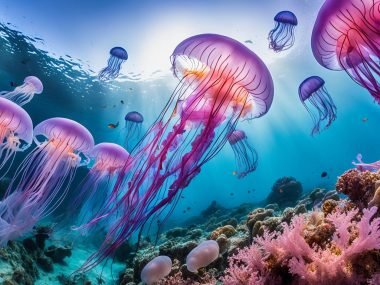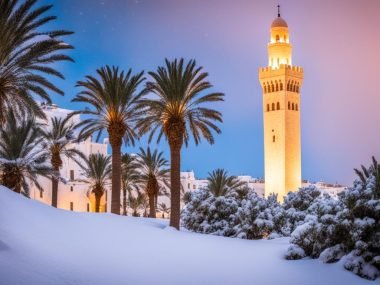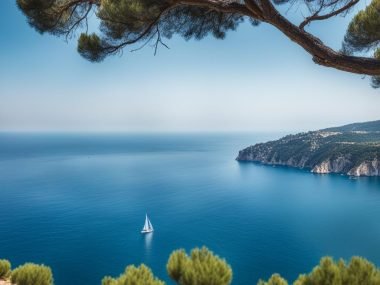Did you know Jebel ech Chambi is Tunisia’s tallest mountain? It stands at 1,544 metres (5,066 feet). That’s higher than both the Eiffel Tower and the Empire State Building! Jebel ech Chambi is a famous natural landmark in Tunisia.
Jebel ech Chambi is part of the North African mountains. It is not just a tall mountain but also important for Tunisia’s geography. It shows the beauty and importance of natural landmarks.
Key Takeaways
- Jebel ech Chambi is the tallest mountain in Tunisia, standing at 1,544 metres (5,066 feet).
- It is a significant feature within the North African mountain ranges, symbolising Tunisia’s natural heritage.
- Jebel ech Chambi’s elevation surpasses iconic landmarks like the Eiffel Tower and the Empire State Building.
- The mountain forms an essential part of the diverse and scenic geography of Tunisia.
- Understanding Jebel ech Chambi provides deeper insights into Tunisia’s geography facts and mountain elevation.
Introduction to Tunisia’s Geography
Tunisia sits on North Africa’s Mediterranean Coast. It’s small but has many types of places. You’ll find hills, big fields, deserts, and fertile areas in the east. Each area shows something special about Tunisia’s geography.
In Tunisia, lots of olives grow, especially in the fertile Sahel area. The country has green, farming land in the east. But it also has dry deserts in the south. This mix shows the North Africa environment diversity.
The Atlas Mountains run from the Algerian border to the Cape Bon peninsula. They make the country look beautiful. These mountains are a big part of the Tunisia geography facts. They show how varied the land is here.
Tunisia’s spot on the Mediterranean Coast makes it very important. It connects Europe and Africa. Its beauty and the North Africa environment diversity interest many people. They love to study it.
The Atlas Mountains in Tunisia
The Atlas Mountains in Tunisia stretch from Northern Africa. They form a beautiful natural barrier. This shapes the region’s look and feel.
The Atlas Mountains in Tunisia form part of the Saharan Atlas, with sub-ranges like the Tabassah Mountains.
Many ridges make up the mountains, forming different shapes in the land. The Tabassah Mountains are one part of the big Saharan Atlas. This stretches across Northern Africa. It adds to the area’s special scenery.
The mountains have Jebel ech Chambi, Tunisia’s tallest peak. They are full of life and history. You’ll find high mountains and green valleys.
We should learn more about these mountains. They are important to Tunisia’s culture. They also attract those who love nature and adventure.
Jebel ech Chambi: Tunisia’s Highest Peak
Jebel ech Chambi is in Kasserine, Tunisia. It is the tallest peak there. This makes it a place worth seeing.
Location and Coordinates
Jebel ech Chambi is near Algeria. It is at 35°12′24″N 8°40′59″E. It is very important to the area and is Tunisia’s highest point.
Jebel ech Chambi Summit Height
The top of Jebel ech Chambi is 1,544 metres high. This makes it Tunisia’s highest peak. Many people come to see its beauty.
Geological Composition
Jebel ech Chambi is made of limestone. The rock tells us about earth’s history. It shows how the peak formed over time.
How Tall Is The Tallest Mountain In Tunisia?
Jebel ech Chambi is the tallest mountain in Tunisia. It is 1,544 metres (5,066 feet) tall. This height makes it a standout feature in Tunisia.
The Tunisia tallest mountain height is not just a number. It attracts researchers and nature lovers. Jebel ech Chambi is in the Kasserine Governorate, showing Tunisia’s beautiful nature.

Jebel ech Chambi’s towering height sets a standard. It is used to compare with other mountains in Tunisia. This shows how varied Tunisia’s land is.
Jebel ech Chambi’s height is more than just a figure. It represents the high points in North Africa’s land. The Tunisia tallest mountain height is fascinating. It fills us with wonder.
| Mountain | Height (metres) | Height (feet) |
|---|---|---|
| Jebel ech Chambi | 1,544 | 5,066 |
The Climate and Ecology of Jebel ech Chambi
Jebel ech Chambi in Tunisia is full of natural beauty. It has a special climate and many types of plants and animals. This place is a great example of nature living in harmony.
Forest Cover
Jebel ech Chambi is covered with Aleppo pine trees. These trees love the Mediterranean weather here. They help keep the area’s animals and other plants thriving.
Wildlife Species
Different animals call this mountain home. You’ll find Cuvier’s gazelles and Barbary sheep here. They all live together in this special place.
Plant Communities
There’s also a wide variety of plants on Jebel ech Chambi. From holm oak to Stipa grasses and Sorbus aria. Each plant adds to the area’s beauty.
Exploring Jebel ech Chambi shows us a world full of life. It’s an important spot for many plants and animals.
Exploring Chambi National Park
Chambi National Park was made in 1980. It helps protect Jebel ech Chambi’s nature. It’s big, at 6,723 hectares, and offers great adventures in Tunisia.
This park is key in keeping many plants and animals safe. Chambi National Park is a must-see for those who love nature and science.
- Biodiversity: Many kinds of life call the park home.
- Ecological Stewardship: The park shows Tunisia’s care for nature.
Visiting Chambi National Park is both fun and learning. It shows Tunisia’s work to keep its nature beautiful.
The Trek to the Summit
Going to the top of Jebel ech Chambi is a big adventure with lovely views. It is Tunisia’s tallest peak. It calls to those who love to see North Africa’s beauty.
Access Routes and Trails
There are many ways to get to Jebel ech Chambi. They suit both new and keen walkers. The most used path starts with a drive up to 1,300 metres.
Then, walkers go on a clear trail for about two hours to the top. This path shows many beautiful scenes. You’ll see green forests and rough mountains.
Hiking Experience
Walking up Jebel ech Chambi is truly amazing. The views get even better as we go up. The paths are just right, being both not too easy and not too hard.
This makes the walk really special. It is great for both first-timers and those who love hiking. The walk is both tough and exciting.
For those looking to hike in Tunisia, Jebel ech Chambi is the top choice. Each step shows more of its beauty. The climb’s effort is totally worth it for the top views.
Comparing Jebel ech Chambi with Other Tunisian Peaks
Jebel ech Chambi is Tunisia’s tallest mountain. It reaches up to 1,544 metres (5,066 feet). This makes it higher than any other peak in the country. To grasp Tunisia’s varied landscapes, we must also explore other key mountains.

Let’s look at some other big mountains in Tunisia, under Jebel ech Chambi. Bireno hits 1,419 metres (4,656 feet) high. Right after, Jebel el Ajered stands at 1,385 metres (4,544 feet). These mountains show how different each peak is, making Tunisia’s geography special.
| Mountain Name | Elevation ( metres ) | Elevation ( feet ) |
|---|---|---|
| Jebel ech Chambi | 1,544 | 5,066 |
| Bireno | 1,419 | 4,656 |
| Jebel el Ajered | 1,385 | 4,544 |
Jebel ech Chambi is not just the tallest in Tunisia. It shows the big height differences across Tunisia’s peaks. Every mountain adds to the nation’s stunning nature and wide range of landscapes.
The Historical Significance of Jebel ech Chambi
Jebel ech Chambi is very important in Kasserine’s past. It’s in the Kasserine area. Many historical events happened here. The mountain’s height makes the area beautiful. It also tells many stories from the past.
Here is a list of big historical events at Jebel ech Chambi and other places in Kasserine:
| Year | Event | Location | Historical Impact |
|---|---|---|---|
| 1943 | Battle of Kasserine Pass | Kasserine | Turning point in North African Campaign during WWII |
| 7th Century | Byzantine Rule | Jebel ech Chambi | Fortified positions aiding defence strategies |
| 16th Century | Ottoman Control | Entire Region | Integration into Ottoman Empire |
| 1956 | Independence of Tunisia | Tunisia including Kasserine | End of French control, significant for national history |
People in Kasserine really respect Jebel ech Chambi. It’s more than just the tallest mountain in Tunisia. Its slopes helped in many ways, like in wars and in keeping culture. Knowing its story helps us feel close to the past. It blends nature with human stories.
Security Concerns and Conservation Efforts
Jebel ech Chambi is Tunisia’s prized gem. It is known both for its beauty and challenges. The area is a focus of security and green efforts.
Military Operations
The security worries around Jebel ech Chambi have led to constant military efforts. These aim to tackle threats and keep the region safe. It’s vital to keep peace for people and nature here.
Conservation Status
There are big steps taken to protect Jebel ech Chambi’s wildlife. Actions include planting more trees, saving unique animals, and encouraging eco-friendly visits. It’s all about keeping the mountain safe and green.
The journey to harmonise safety and green aims at Jebel ech Chambi continues. Despite hurdles, there’s strong will to guard this natural treasure. It shows Tunisia’s promise to a secure and green future.
UNESCO Biosphere Reserve Designation
In 1977, UNESCO made Jebel ech Chambi a special biosphere reserve. This big step helped everyone see how important it is to live in harmony with nature.
Jebel ech Chambi covers a huge 43,723 hectares. It shows the world how vital it is to protect our planet’s ecosystems. This area benefits from being known worldwide. It helps local people save their natural treasures.
“The designation of Jebel ech Chambi as a UNESCO biosphere reserve not only marks a milestone for Tunisia but is also a critical step towards sustainable environmental management across North Africa.” – UNESCO Representative
Thanks to this status, Jebel ech Chambi leads by example. It’s part of a bigger effort in North Africa. These places work together to keep nature safe. They also study the environment to learn more.
Many projects in the reserve look after nature. They also help people learn about the environment. Exploring Jebel ech Chambi shows us why such areas are key. They protect life on Earth and the places we live.
| Attribute | Details |
|---|---|
| Designation Year | 1977 |
| Total Area | 43,723 hectares |
| Key Focus | Biodiversity Conservation and Sustainable Development |
Conclusion
Jebel ech Chambi is the tallest mountain in Tunisia. This fact highlights our country’s wonderful natural heritage. This mountain is not just tall. It is also a key part of Tunisia’s nature and geography.
Jebel ech Chambi is important for other reasons too. It shows how much we want to keep our natural beauty safe. By looking after Tunisian mountains, we protect the environment. This also lets future generations enjoy Jebel ech Chambi’s untouched beauty.
This mountain stands tall as a reminder. It tells us that we must keep working hard to protect such places. By doing so, we help our environment and communities thrive. Let’s work together to care for Tunisia’s natural wonders.







